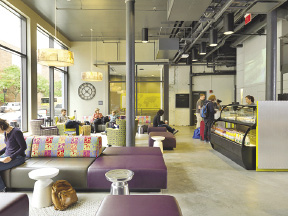The creation of the new Hostelling International Boston (HI-Boston) flagship was rooted in the desire to capture the attention of a more design-conscious market, celebrate the rehabilitation of an existing historic urban building, facilitate intercultural and social interaction, and highlight efficiency and sustainability. The architect on this project was Bergmeyer Associates, Inc.
HI-Boston is located in The Dill Building, a historic masonry and wood frame building constructed between 1886 and 1888 in downtown. The adaptive reuse project retained nearly all of the building's existing structure and shell, significantly reducing the amount of waste created by demolishing the building and constructing a new one.
The hostel is designed to use 22% less energy than a similar building. New spray-foam insulation at the building's exterior walls reduces heat loss in the winter and keeps the building cooler in the summer. New windows eliminate drafts and air infiltration. The boilers are all high-efficiency, and even the elevators reduce energy demand. All appliances in the guest kitchens as well as in the coffee bar are Energy Star rated.
Individual task lights installed at every bed reduce the amount of overhead lighting needed. LED lights are used in various locations; the balance of the lighting is fluorescent lighting with high-efficiency ballasts. Overhead lights in dorm rooms, bathrooms and public areas operate on occupancy sensors.
Water-conserving products such as low-flow showerheads, faucet aerators and low-flow toilets help the hostel reduced its water consumption by more than 35%.
Green "G" icons with QR codes have been placed throughout the hostel to indicate sustainable design elements and to encourage guests and visitors to learn about these features. Mobile devices can be used to scan the QR codes and take the user to the hostel's website and an information page about that particular sustainable feature.
Tags:
Award for Innovation in Green Design - Building Category: Hostelling International Boston designed to use 22% less energy than a similar building
June 20, 2013 - Spotlights








